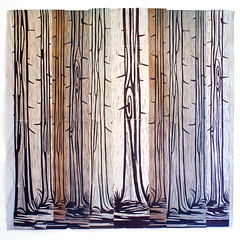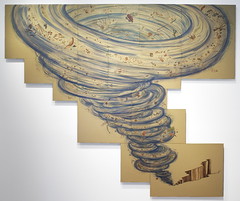The (re)appearance of such craft might have been regarded as auspicious, or ominous, but it proved to be neither: indicating no trend in the near-term. The careful hand of the artist--upon papers of like scale and number--did not return till 10 months had passed.
Carol Jackson at Swimming Pool Project Space, as well as Tony Fitzpatrick and Scott Nadeau at Studio 1020, among others, did present "well-drawn" two-dimensional objects of art. But, compared to O'Neil and Davis/Langlois, they did so on a smaller scale, or with a smaller number of pieces, or outside of a conceptual framework of their own creation.
Maybe more closely related to the subject of this review was Jason Middlebrook's May 2010 solo show at Monique Meloche Gallery in which he (Middlebrook) reinforced a thematic concern for the management and allocation of natural resources by means of connecting large-scale, representational drawings to a site-specific installation. But Middlebrook's drawing was only ancillary to his three-dimensional work.
That much (above) has been written NOT for the purpose of dismissing the aforementioned artists or spaces--but rather as a remembrance and acknowledgment of them. Too, it seems good to provide context. In this year, Lora Fosberg should be connected to: Robyn O'Neil, Robert Davis and Michael Langlois, Carol Jackson, Tony Fitzpatrick, and Jason Middlebrook at least.
+ + +
Within Lora Fosberg's graphic narratives the elements of text and image were expected to diverge: one having grown at the expense of the other.

Whether beginning with Zoroaster, the simple dichotomy is a pattern too familiar in the history of the West. So that even late in so-called Modernity (Friedrich Nietzsche to Camille Paglia at least) it's been possible for cultural observers to borrow from Greek antiquity the motifs of the Apollonian and Dionysian: identifying two contemporary tendencies in opposition to one another, usually as part of an analysis by contrast.
For a critic to want to "read" a visual artist as pointing, compass-like, in a particular direction, seems natural--as any theorist's claim to prowess stems from an ability to offer the insight or framework which allows experience to be structured in such a way that meaning is the result.
In Fosberg's case, acknowledging both the duality which does exist and also the temptation to draw out incongruities, what's actually happened across her oeuvre is something else altogether: she has, surprisingly, managed to sustain the (relatively) equal development of two distinct avenues of expression.
Whether united in a single composition, both (her text and image) have continued to recall one another as a result of a common palette and her hand drawn line. There's no gloss. There's little vivid color. Everything looks as though it was produced by the same person, with care, over time--maybe even some time ago.
Having written that, the successful synthesis which culminates in Fosberg's exhibition, "You Can’t Fall Off The Floor," isn't explained by the warm tone or matte patina seeming to cover the art.
Fosberg does well because her practice has evolved to treat words and pictures as modular, graphic units--rather than as parts of a fixed composition. As goes the pithy quote painted on paper, so goes the tree trunk print. Here, it's important to pay attention to method.

Two years ago the size of a finished piece was determined aforehand by the size of the paper upon which she began to work. Then, while continuing to draw on the same (small) scale, her pieces grew in size as multiple papers (serving to ground individual drawings) were collaged upon panels. Now, those panels are found set beside each other. Or, those panels are discarded altogether--and paper is collaged directly upon wall surfaces.
Fosberg has become heavily engaged in the acts of building and layering, albeit working closely to the vertical surface of the wall. She's flirting with low relief sculpture and (fiber art) textiles, and is no longer bound by the page. Pieces run on as long as she pleases. As a result, much of her work is now infinitely scalable.
That feminine aspect of the Dionysian which was manifest in the maenads--chaotic, sexual, immoderate, even violent beings--is visible upon close inspection of some of Fosberg's pieces. And that's where she seems to be at her strongest: glancing, oblique, abstract, her subtext quietly revealing an enigmatic challenge contrary to Man's effort to understand, to control, Nature.

Lora Fosberg
"You Can’t Fall Off The Floor"
June 25 - August 21, 2010
Tues–Sat, 11-5 PM
Linda Warren Gallery
1052 West Fulton Market
Chicago, IL 60607-1207
http://www.lindawarrengallery.com
Lora Fosberg,
http://lorafosberg.com
- Paul Germanos
No comments:
Post a Comment